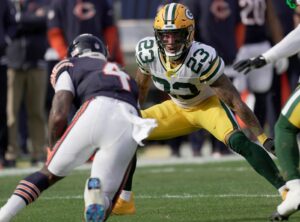Progressing through Last Word On Pro Football’s “The Breakdown” series, we take a look at what the Tennessee Titans prefer to do on both sides of the ball.
The Breakdown: A Look at the Tennessee Titans Schematic Philosophy
Exotic Smashmouth
Head coach Mike Mularkey has built a unique, diverse system led by their budding star at quarterback, Marcus Mariota. The “exotic smashmouth” phrase comes directly from Mularkey and his desire to stress defenses in ways that have seldom been done.
Mularkey’s reliance on multi-back sets is what allows running backs Derrick Henry and DeMarco Murray to essentially compliment and feed off of each other. His multi-tight end sets have opened the gates of production for Delanie Walker and should further their success through the air with the addition of Florida International tight end, Jonnu Smith. These multi-sets are often used in lieu of three and four-receiver groupings while putting bigger bodies on the line can reduce the possibility of producing tendencies. But the additions of Corey Davis, Taywan Taylor and Eric Decker suggests Tennessee wants streamlined efficiency from their wide receivers.
Because the Titans feature versatile tight ends, they will often put as many as three on the field at once to establish their run game, furthering their creativity-and ultimately their effectiveness-in play-action. The Titans led the league in the use of 22 personnel (two backs, two tight ends) last season in which they ran the ball 87 percent of the time. That creates a rather predictable trend, but Tennessee will execute both their drop back and play-action game out of 22. The latter torched defenses who were hyper-focused on the developing runs being sold. When the offense goes heavy, the defense reacts to runs aggressively and opens up obvious throwing lanes behind them. Being able to run the ball as consistently and diversely as the Titans do eliminates offensive limitations in both the drop back passing game and play-action, and further allows the offense to control the clock and the tempo.
The use of the tight ends simply doesn’t stop there, however. That aforementioned versatility at the position creates a legitimate threat to defenses that are unsure of whether they should match these tight ends up with a linebacker to defend the run or treat them as pass catchers when the offense goes heavy.
Mularkey and Mariota have blended well together to enhance Tennessee’s drop back passing game. The use of pre-snap shifts and motions provide Mariota with clearly-defined reads, while Mularkey’s route concepts are adept at stretching both planes of the field and beating both man and zone coverage. Mariota is a highly intelligent quarterback that can quickly identify coverages and maintain his tempo with the bevy of timing-based patterns Mularkey incorporates. Look for Tennessee to continue working their vertical passing game with improved efficiency following the additions of Davis and Taylor.
The Zone Blitz
Defensive coordinator Dick LeBeau enters his third season as the Titans’ head defensive man, but has spent four decades as an NFL coach and cemented himself as one of the game’s all-time great defensive minds.
LeBeau has become the godfather of the zone blitz defense that is essentially built on element of confusion where defenders will crowd the line and show blitz, but ask some to rapidly drop into zone coverage as the other disguised blitzers rush. He sought a new way to play safe coverage behind a blitz rather than manning up across the board and forcing his four or five defensive backs to play near-perfect coverage against the offense’s weapons.
From there, LeBeau refined the Fire Zone Blitz, a three-deep, three-under attack that can operate from a litany of different fronts and alignments and features the weak-side defensive end dropping into coverage away from the blitz as pressure ensues from the opposite side of the formation. Traditionally run out of a 3-4, the three defensive linemen will generally slant away from the blitzing linebackers in an attempt to draw protection towards them and open up free rushing lanes along the backside. As for the linebackers tagged with coverage duties, they ultimately zone the areas vacated by blitzers and make life increasingly difficult on quarterbacks looking to throw hot.
The zone blitz operates with cover one, two or three behind it, while Tennessee featured numerous personnel groupings and gap-exchange blitzes in 2016. Working with cover one and three provides the defense with a rangy centerfielder that can drive to the deep areas of the field and serve as a reliable last line of defense. Tennessee did shift to a heavier use of 2-man towards the end of the season when corner back Jason McCourty saw this game fall off significantly. This was ultimately the catalyst for spending their first round draft pick on USC corner Adoree’ Jackson.






